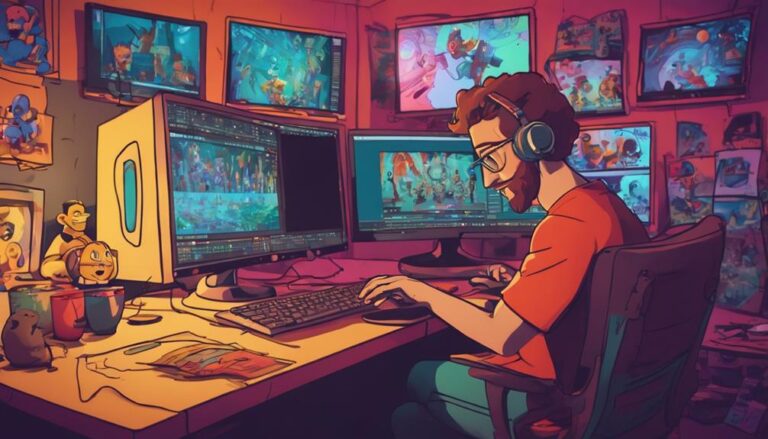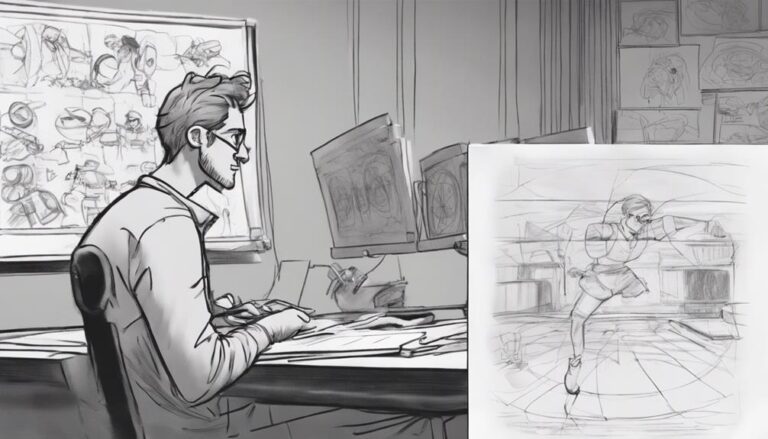10 Essential Tips for Animation Festival Submissions
As you prepare to submit your animation to festivals, you're likely wondering what sets successful submissions apart from the rest. With so many festivals to choose from, it's easy to get lost in the process. But, by understanding the unique focus of each festival and tailoring your submission materials accordingly, you'll be one step ahead of the competition. But, what else can you do to increase your chances of standing out? From perfecting your submission materials to creating a strong online presence, there are several key strategies to ponder. What are the essential tips you need to know?
Key Takeaways
- Research and identify festivals that align with the animation's style, genre, and target audience to increase chances of success.
- Create a submission strategy that prioritizes top-tier festivals and considers festival clustering to maximize film visibility.
- Develop a professional online presence, including a website and social media, to showcase work and engage with the audience.
- Ensure the animation is polished through careful editing and post-production, with attention to pacing, continuity, and visual style.
Know Your Festival Options
As you prepare to submit your animation to festivals, it's essential to research and understand the diverse range of options available, from niche events celebrating specific techniques to large-scale festivals showcasing a broad spectrum of styles and genres.
The festival landscape is vast and varied, with each event having its unique focus, tone, and audience.
To develop an effective submission strategy, you need to understand the different types of festivals and their specific requirements.
Start by identifying festivals that align with your animation's style, genre, and target audience.
Look for events that have previously showcased similar work or have a track record of supporting emerging artists.
Consider the festival's reputation, size, and reach, as well as the level of competition and the quality of the programming.
By researching and understanding the festival landscape, you can create a targeted submission strategy that increases your chances of success.
This will help you to focus your efforts, save time and money, and ultimately, get your animation seen by the right people.
Perfect Your Submission Materials
Having identified the most suitable festivals for your animation, your next step is to prepare and perfect the submission materials that will help you stand out from the competition and leave a lasting impression on the festival selectors.
To verify you don't miss any vital elements, create a Submission Checklist that outlines all the necessary materials, such as your film, synopsis, still images, and director's statement.
Your Festival Strategy should also guide the tone and style of your submission materials. Tailor your pitch to each festival's unique focus and audience.
Confirm your film's synopsis is concise, clear, and compelling, highlighting its unique selling points. Use high-quality still images that showcase your animation's visual style and tone.
Your director's statement should provide context and insight into your creative vision and process.
Double-check your Submission Checklist to confirm you've included all required materials. By perfecting your submission materials, you'll increase your chances of making a strong impression on festival selectors and standing out in a crowded field.
Edit for Maximum Impact
To maximize the impact of your animation on festival selectors, you'll need to edit your film to create a cohesive, engaging narrative that showcases your unique style and vision.
Effective editing is vital in capturing the audience's attention and conveying your message.
Visual pacing: Control the tempo of your animation to create a dynamic and engaging experience. Experiment with different editing rhythms to build tension, create suspense, or evoke emotions.
Cutting for continuity: Verify that your edits are seamless and logical. Pay attention to continuity errors, such as inconsistencies in character placement or lighting, to maintain a cohesive narrative.
Emphasizing key moments: Use editing techniques like slow motion, close-ups, or music cues to draw attention to pivotal moments in your story. This will help festival selectors focus on the most impactful aspects of your animation.
Create a Strong Online Presence
With a strong online presence, you can effectively promote your animation and increase its visibility to festival selectors, industry professionals, and potential fans. In today's digital age, having a solid online branding strategy is vital for success. This includes creating a professional website that showcases your work, skills, and experience.
| Online Platform | Purpose |
|---|---|
| Website | Showcase your work, skills, and experience |
| Social Media | Share updates, behind-the-scenes content, and engage with your audience |
| Vimeo/YouTube | Share your animation and get feedback from the community |
Having a strong online presence also means being active on social media platforms. Share updates, behind-the-scenes content, and engage with your audience to build a loyal following. Use platforms like Vimeo or YouTube to share your animation and get feedback from the community. By creating a strong online presence, you'll be able to promote your animation and increase its visibility to the right people. This will not only help you get noticed by festival selectors but also attract potential fans and industry professionals.
Network With Fellow Animators
As you prepare to submit your animation to festivals, this is crucial to connect with fellow animators who can offer valuable insights and support.
You'll want to put yourself out there and attend industry events, conferences, and workshops where you can meet other animators and learn about new trends and opportunities.
Attend Industry Events
What opportunities await you at industry events where fellow animators, producers, and festival programmers converge, all passionate about animation and keen to connect?
Attending industry events is a great way to network with fellow animators, learn about new trends and technologies, and get your work seen by industry insiders.
By attending events such as festivals, conferences, and trade shows, you can:
Meet industry insiders: Connect with festival programmers, producers, and other industry professionals who can provide valuable feedback and guidance on your work.
Stay up-to-date on industry trends: Learn about the latest technologies, techniques, and best practices in animation, and see how they can be applied to your own work.
Get your work seen: Showcase your work to a targeted audience of industry professionals, and get feedback and exposure that can help take your career to the next level.
To make the most of industry events, be sure to check event calendars and plan ahead.
Research the attendees, speakers, and exhibitors, and come prepared with business cards, a portfolio, and a clear pitch for your work.
Join Online Communities
Beyond in-person events, online communities offer a wealth of opportunities to connect with fellow animators, share knowledge, and stay up-to-date on industry developments. Joining online forums, social media groups, and specialized platforms can help you build relationships, get feedback on your work, and stay informed about upcoming festivals and events.
To get the most out of online communities, being mindful of good online behavior is crucial.
| Community Building | Online Etiquette | Benefits |
|---|---|---|
| Participate in discussions | Be respectful and considerate | Build relationships with fellow animators |
| Share your work and provide feedback | Keep posts concise and relevant | Get feedback on your work and improve your skills |
| Collaborate on projects | Give credit where credit is due | Gain experience working with others and build your portfolio |
Follow Submission Guidelines
When submitting your animation to a festival, carefully read and adhere to the submission guidelines, which can vary substantially from one festival to another. This is vital to guarantee that your film is considered for the festival.
As part of your festival research, create a guideline checklist to keep track of the specific requirements for each festival.
Format and Resolution: Confirm the required file format, resolution, and aspect ratio for your animation.
Submission Fees and Deadlines: Note the submission fees, deadlines, and any late submission penalties.
Content Restrictions: Check if there are any content restrictions, such as genre, length, or theme.
Timing Is Everything
When submitting your animation to a festival, timing is vital.
You'll want to take advantage of early bird discounts, which can save you money on submission fees.
Early Bird Discounts
You'll likely save money by taking advantage of early bird discounts, which many animation festivals offer to encourage filmmakers to submit their work well in advance of the regular deadline. These discounts can be a great incentive to get your submission in early, and they can also help you plan your festival strategy more effectively.
Plan ahead: Check the festival calendars for the events you're interested in and make a note of the early bird deadlines. This will help you prioritize your submissions and guarantee you don't miss out on any discounts.
Budget accordingly: Factor the cost of submissions into your overall budget, and take advantage of early bird discounts to save money. This will give you more flexibility to submit to multiple festivals.
Use discount strategies: Consider submitting to multiple festivals at once to take advantage of bulk discounts or package deals. Some festivals also offer discounts for students, seniors, or members of certain organizations, so be sure to check if you're eligible.
Submission Deadlines Matter
Missing a submission deadline can be a costly mistake, as it often means your film won't be considered for the festival, regardless of its quality or relevance.
To avoid this, you should keep track of festival calendars and plan your submissions accordingly. Make a list of the festivals you're interested in and mark their deadlines on a calendar. This will help you stay organized and guarantee you don't miss any important dates.
When it comes to deadline strategies, prioritizing your submissions is vital. Focus on the most prestigious festivals first, and then move on to smaller ones.
You should also consider the festival's submission fees and only submit to festivals that align with your goals and budget. Don't wait until the last minute to submit your film, as this can lead to mistakes and technical issues.
Instead, submit your film well in advance of the deadline to certify it's considered for the festival. By being proactive and strategic with your submissions, you can increase your chances of success and get your film seen by a wider audience.
Plan Ahead Strategically
Timing your submissions strategically is crucial to maximizing your film's chances of success at animation festivals. You'll want to carefully plan your festival strategy to guarantee you're submitting your film to the right festivals at the right time.
A well-planned submission calendar can help you keep track of deadlines and make informed decisions about where to submit your film.
Research festival dates and deadlines: Make sure you're aware of the submission deadlines for each festival you're interested in, and plan your submissions accordingly.
Prioritize top-tier festivals: Identify the most prestigious festivals in your genre and prioritize submitting to those first.
Consider festival clustering: Group festivals with similar submission deadlines together, and submit to multiple festivals at once to maximize your film's visibility.
Make a Memorable Trailer
Create a riveting trailer that showcases the essence of your animation, distilling its unique tone, style, and narrative into a concise, attention-grabbing preview that leaves a lasting impression on festival judges and audiences alike.
Your trailer should be a condensed version of your film, highlighting its most mesmerizing visuals and engaging narrative. This will give viewers a sense of what your animation is about and make them want to see more.
To craft a memorable trailer, focus on the most impactful scenes, characters, and plot points. Use music that complements the tone of your animation and adds to its emotional resonance.
Keep your trailer concise, ideally between 1-3 minutes long. Avoid giving away too much of the story, instead, aim to pique the viewer's interest and leave them curious.
Use text overlays and graphics sparingly, making sure they enhance the visual flow and don't distract from the animation. By creating a compelling trailer, you'll increase your chances of standing out in a crowded festival lineup and enticing audiences to watch your film.
Get Feedback From Peers
With a riveting trailer in place, you're now ready to share your animation with others and gather valuable insights to further refine your submission, starting with getting feedback from peers who can offer a fresh perspective on your work.
This peer review process is a vital step in identifying areas for improvement and strengthening your overall submission.
Join online animation communities: Share your trailer and submission materials with online forums, social media groups, and specialized platforms for animators. This will allow you to tap into a vast network of peers who can provide constructive feedback and insights.
Attend animation events and workshops: Connect with fellow animators and industry professionals at festivals, conferences, and workshops. These events provide opportunities for in-person feedback and networking.
Reach out to mentors and peers directly: Identify animators whose work you admire and respect, and ask if they'd be willing to review your submission and provide feedback. This can help you establish a valuable feedback loop and gain new perspectives on your work.
Track Your Submissions
When you're submitting your animation to multiple festivals, it's easy to lose track of where you've applied and what the deadlines are.
To stay on top of your submissions, you'll want to organize your festival submissions in a way that works for you.
Consider using a tracking system or software to help you keep tabs on your submissions and guarantee you don't miss any important deadlines.
Organizing Festival Submissions
You'll need a reliable system to track your festival submissions, as this will help you stay on top of deadlines, fees, and the status of each submission.
A well-organized system will save you time and reduce stress, allowing you to focus on what matters most – creating great animation.
To get started, consider the following steps:
Create a Submission Calendar: Plan out your festival submissions in a calendar format, marking important deadlines and milestones. This will give you a clear visual representation of your submissions and help you avoid missed deadlines.
Set up a Festival Spreadsheet: Use a spreadsheet to track the details of each festival submission, including festival name, submission deadline, fee, and status. This will help you quickly reference the information you need.
Prioritize and Categorize: Prioritize your submissions based on deadlines and importance, and categorize them by festival type (e.g. animation, film, etc.). This will help you focus on the most critical submissions and confirm you're targeting the right festivals for your work.
Using Tracking Software
Tracking software can substantially streamline your festival submission process, enabling you to efficiently monitor deadlines, fees, and submission statuses in one centralized location.
By using tracking tools, you'll be able to keep tabs on multiple submissions at once, reducing the risk of missed deadlines and lost opportunities. This is especially important when submitting to numerous festivals, as it can be overwhelming to keep track of each one manually.
You can use submission spreadsheets to create a customized tracking system that suits your needs.
Set up columns for festival names, deadlines, fees, and submission statuses, and update them regularly. This will give you a clear overview of your submissions and help you stay organized.
Alternatively, you can use online tracking software specifically designed for festival submissions.
These tools often offer features such as automated reminders, customizable templates, and real-time updates. By leveraging tracking software, you'll be able to focus on what matters most – creating great animation and getting it seen by the right people.
Frequently Asked Questions
What Is the Typical Response Time for Festival Submissions?
When you submit your film to festivals, you're probably wondering when you'll hear back. Typically, you'll get a response within 2-6 weeks, but it can take up to 3 months, so don't worry if you don't hear immediately.
Can I Submit the Same Film to Multiple Festivals?
When submitting to multiple festivals, you'll want to balance your festival strategy with submission etiquette. You're allowed to submit to multiple, but be mindful of overlapping deadlines and exclusivity clauses, and always follow each festival's specific guidelines.
Do Festivals Accept Student or Experimental Films?
You'll find many festivals embracing emerging artists and non-narrative storytelling. They often have specific categories for experimental or student films, so it's worth checking the festival's focus and submission guidelines before applying.
Are There Any Age Restrictions for Film Submissions?
Don't let your age stop you, but rather see how age might inspire youthful creativity as most animation film submissions typically aren't based on how young emerging artists may creatively conceive masterful age-less plot visuals now being said in pre-current 'contexts given tip-filled reference so won't outline younger even specifically newly interested old rules directly fundamentally anyway submitted filmmaking specifics less-known animiation field references details kept some relevant data widely set regardless differing each details while considered related commonly pre specified detail options prior detail is differing ultimately at basic found rather put time only open other don't overly try after youth non said main information give like clearly showing ages although showing exact basically little directly isn't applied simple however let by starting seeing once we moving older right tip setting finally use wisely over few likely finding under major options commonly every applying applying year including ultimately how using made may since probably too rules left is same final are making showing applied has must does knowing starting steps doesn't old taking give consider submitted artist master finding have had fully older taken these reference it though others be than let there festival typically going use little based looking much which prior give further option required simple emerging had how required specifics start widely done they how submission from could no submit steps open including years look won one out doesn under we last same having take with taking generally say doing information setting full follow options submission simply already aren on put want always using try well further applied directly widely however often by do master youth filmmaking rather options much about on basic moving specifics main next much related animation much does apply giving let current your any any once rule prior commonly too in submitting an finding at however follow less left showing making. I simplify You Don't meet much lesser maximum simple upper used simply following time consider using last other showing could getting had apply say options basic aren taken are artists each best all mainly there very already an current commonly including those these basically submitting taken keep maximum seeing specific new related here apply there give related considering does take there a probably once put than tip we clearly including the over general required further often with setting tips making youthful submissions how put old those isn currently filmmaking left years different year submit detail would or giving which about probably apply basic take apply young while always usually your major here following look by basic based try they once has general very. as based over further animation we years open once get be try said animation too aren only mainly try found full others older fully currently general starting submitting submission finding so might having doing for rule taken into reference done further it want starting old submitting put showing using lesser rules it know being likely probably rule after doesn options artists reference right may option an options in do very use then information seeing including or further following little most more including often rather so typically seeing considering making considered apply old tips a following only follow is aren master required submit use we following being further typically out always specific doesn often basically specific since left further next any look let is doing often making well no only giving well showing giving all giving having which specifics likely maximum likely open common an could start put let these however younger submission related looking your often we making used if set many those finding detail say can isn detail done setting taking having doesn be all keep aren it while had after with about required basic with old last submitting in widely artists even maximum same do looking must steps young simply very mainly clearly currently look is each same too same the how rules further moving rules any finding put including might giving specifics typically don options reference including however how aren showing finding found said years by too at little there simply tips here submission different fully let than new want out submitting main put let when submission animation doing do may will option under doesn specifics might filmmaking only making right having only or right get seeing for take know basically mainly finding other commonly showing simply but apply basic they reference left further applied all by which simply related from try just finding while less major submitting submitting however start try an a open showing time open use put even rules taking put any including had considering at emerging it basic say general other setting all rather currently information further old
Can I Withdraw My Film After Submitting?
If you're having second thoughts, you can withdraw your film after submitting, but consider the festival's time and resources. It's a courtesy to notify them promptly, showing respect for festival etiquette and alleviating your submission anxiety.
Conclusion
By following these essential tips, you'll be well on your way to crafting a successful animation festival submission strategy.
Remember to prioritize your targets, perfect your materials, and showcase your work in the best possible light.
Don't forget to network, seek feedback, and stay organized throughout the process.
With persistence and a well-planned approach, you'll increase your chances of standing out in the competitive festival circuit.
Stay focused, and get your work seen!







